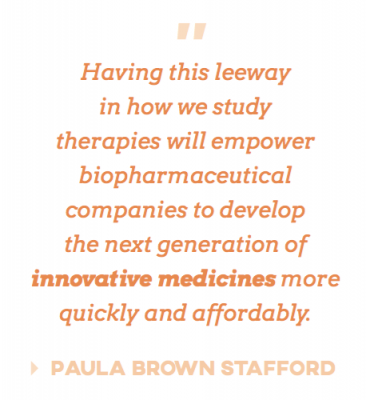How can we improve the process for developing new medicines?
October 15, 2017
Paula Brown Stafford, MPH
Adjunct professor of public health leadership
Gillings School alumna (BSPH and MPH, biostatistics)
President of Quintiles (retired)
In the United States, an average of 31 new medicines and medical devices are approved by the Food and Drug Administration (FDA) each year. To give that number some context, approximately 3,500 treatments currently are being tested. Of those that enter clinical trials, only 12 percent will make it to the market.
If the goal of clinical research is to enhance the lives of patients through new drugs and treatments, then improving how we run clinical trials is a public health priority.
Throughout my career, I’ve worked in companies that have enrolled more than a million patients in clinical trials at nearly 100,000 investigative sites globally. I know from experience that modernizing these trials is critical to delivering better medicines faster, at less cost, to patients who need them.
While the biopharmaceutical industry and the FDA have made great strides already, I think the key to our future progress lies in three areas:
- Utilizing big data approaches to find the right patients for clinical trials;
- Improving our focus on patients, both in how we explain participation benefits and how we share findings; and
- Establishing alternative development pathways to speed the introduction of new therapies.
Q: How can big data help modernize clinical trials?
A: More new medicines are developed in the U.S. than in any other country. That process takes seven to 10 years, on average, and we should never forget that patients in need are waiting at the end of the line.
One issue that slows the creation of medical therapies is the sheer expense of their development. The cost increases year after year, and some promising drugs never reach patients because biopharmaceutical companies have to choose which treatments to prioritize.
This is why using the big data available to us – such as insurance claims and disease registries – is vital to finding the right patients for clinical trials in a timely way. Having the ideal study population enables us to learn the most from each trial, which lowers development costs.
Q: How must researchers improve the focus on patient participants?
A: First, we should do more to build awareness about the possible benefits to patients who join clinical trials. Some see their disease states treated, as in the case of patients in one trial who entered infected with Hepatitis C and left Hep-C-negative. Other patients may experience an improved quality of life or have their life extended beyond what was expected.
 That was the case with my father, actually. He participated in a clinical trial for an oncology product currently on the market. Although we now believe that drug extended my father’s life by one to two years, he passed away before learning the results of the research to which he contributed.
That was the case with my father, actually. He participated in a clinical trial for an oncology product currently on the market. Although we now believe that drug extended my father’s life by one to two years, he passed away before learning the results of the research to which he contributed.
Second, we must commit to contacting patients involved in clinical trials directly, and in a timely manner, to share the outcomes of our research. Some degree of transparency already is required by the FDA, but many companies are so leery of competitors stealing their data that they take quite a while to share heavily-redacted findings.
The truth is that patients who volunteer for clinical trials are contributing to the health and well-being of future generations. They deserve to know whether their participation will go on to improve public health, potentially on a global scale – and they deserve to be thanked.
Q: How will alternate development pathways impact clinical research?
A: In December 2016, Congress passed what is known as the 21st-Century Cures Act. In July 2014, I attended a Congressional hearing to provide expert testimony on this issue. In my statement, I supported the creation of a formal option for companies to use alternate development pathways when researching new medical treatments; this previously had been allowed only on a case-by-case basis.
The new law modifies the FDA’s drug approval process to officially permit the use of these pathways – which include using data summaries and real-world evidence versus full clinical trials – when appropriate.
Having this leeway in how we study therapies will empower biopharmaceutical companies to develop the next generation of innovative medicines more quickly and affordably. In our fast-moving world, scientists generate new molecular knowledge about diseases every day. From this knowledge, we will continue to create drugs that will change the face of public health around the world.
Brown Stafford also is chief development officer at Novan Therapeutics, managing director of Habergeon LLC, and board member at Health Decisions and Novan.
Carolina Public Health is a publication of the University of North Carolina at Chapel Hill Gillings School of Global Public Health. To view previous issues, please visit sph.unc.edu/cph.
